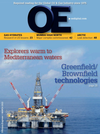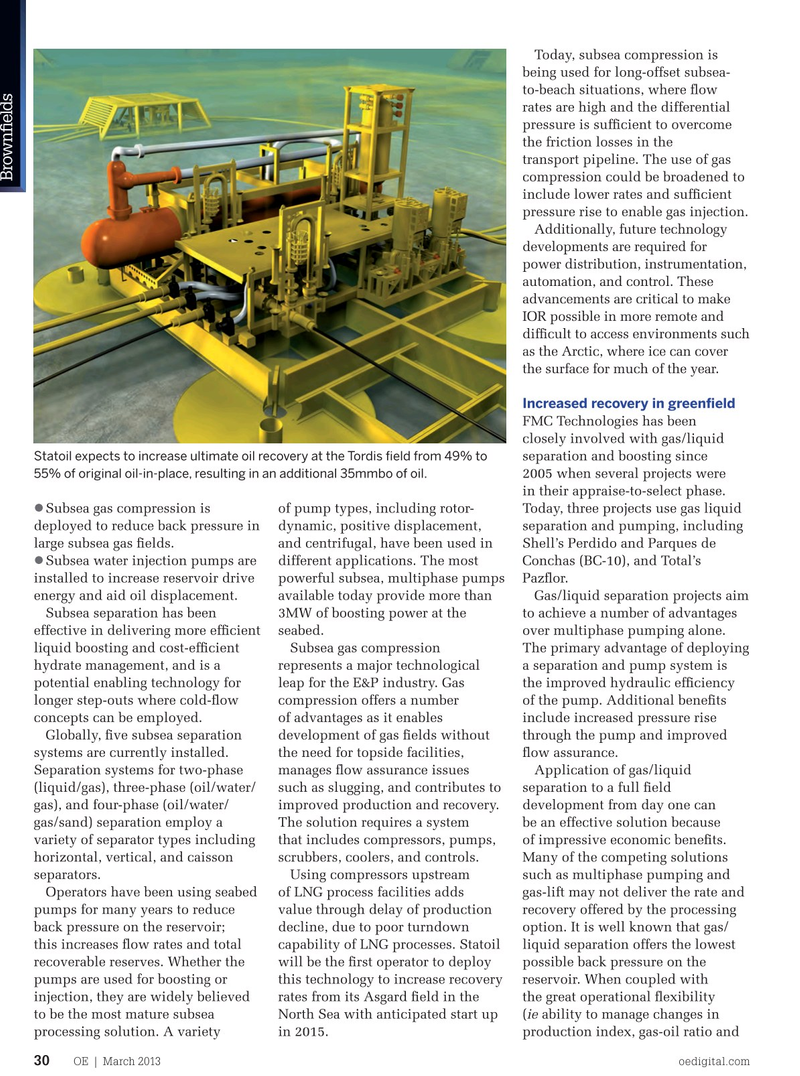
Page 28: of Offshore Engineer Magazine (Mar/Apr 2013)
Read this page in Pdf, Flash or Html5 edition of Mar/Apr 2013 Offshore Engineer Magazine
Today, subsea compression is being used for long-offset subsea- to-beach situations, where fow rates are high and the differential pressure is suffcient to overcome the friction losses in the transport pipeline. The use of gas
Brownfelds compression could be broadened to include lower rates and suffcient pressure rise to enable gas injection.
Additionally, future technology developments are required for power distribution, instrumentation, automation, and control. These advancements are critical to make
IOR possible in more remote and diffcult to access environments such as the Arctic, where ice can cover the surface for much of the year.
Increased recovery in greenfeld
FMC Technologies has been closely involved with gas/liquid separation and boosting since
Statoil expects to increase ultimate oil recovery at the Tordis feld from 49% to 2005 when several projects were 55% of original oil-in-place, resulting in an additional 35mmbo of oil.
in their appraise-to-select phase. l Subsea gas compression is of pump types, including rotor- Today, three projects use gas liquid deployed to reduce back pressure in dynamic, positive displacement, separation and pumping, including large subsea gas felds. and centrifugal, have been used in Shell’s Perdido and Parques de l Subsea water injection pumps are different applications. The most Conchas (BC-10), and Total’s installed to increase reservoir drive powerful subsea, multiphase pumps Pazfor. energy and aid oil displacement. available today provide more than Gas/liquid separation projects aim Subsea separation has been 3MW of boosting power at the to achieve a number of advantages effective in delivering more effcient seabed. over multiphase pumping alone. liquid boosting and cost-effcient Subsea gas compression The primary advantage of deploying hydrate management, and is a represents a major technological a separation and pump system is potential enabling technology for leap for the E&P industry. Gas the improved hydraulic effciency longer step-outs where cold-fow compression offers a number of the pump. Additional benefts concepts can be employed. of advantages as it enables include increased pressure rise Globally, fve subsea separation development of gas felds without through the pump and improved systems are currently installed. the need for topside facilities, fow assurance.
Separation systems for two-phase manages fow assurance issues Application of gas/liquid (liquid/gas), three-phase (oil/water/ such as slugging, and contributes to separation to a full feld gas), and four-phase (oil/water/ improved production and recovery. development from day one can gas/sand) separation employ a The solution requires a system be an effective solution because variety of separator types including that includes compressors, pumps, of impressive economic benefts. horizontal, vertical, and caisson scrubbers, coolers, and controls. Many of the competing solutions separators. Using compressors upstream such as multiphase pumping and Operators have been using seabed of LNG process facilities adds gas-lift may not deliver the rate and pumps for many years to reduce value through delay of production recovery offered by the processing back pressure on the reservoir; decline, due to poor turndown option. It is well known that gas/ this increases fow rates and total capability of LNG processes. Statoil liquid separation offers the lowest recoverable reserves. Whether the will be the frst operator to deploy possible back pressure on the pumps are used for boosting or this technology to increase recovery reservoir. When coupled with injection, they are widely believed rates from its Asgard feld in the the great operational fexibility to be the most mature subsea North Sea with anticipated start up (ie ability to manage changes in processing solution. A variety in 2015. production index, gas-oil ratio and
OE | March 2013 oedigital.com 30 oe_BrownfieldFMC_rev2.indd 30 27/02/2013 11:28

 27
27

 29
29